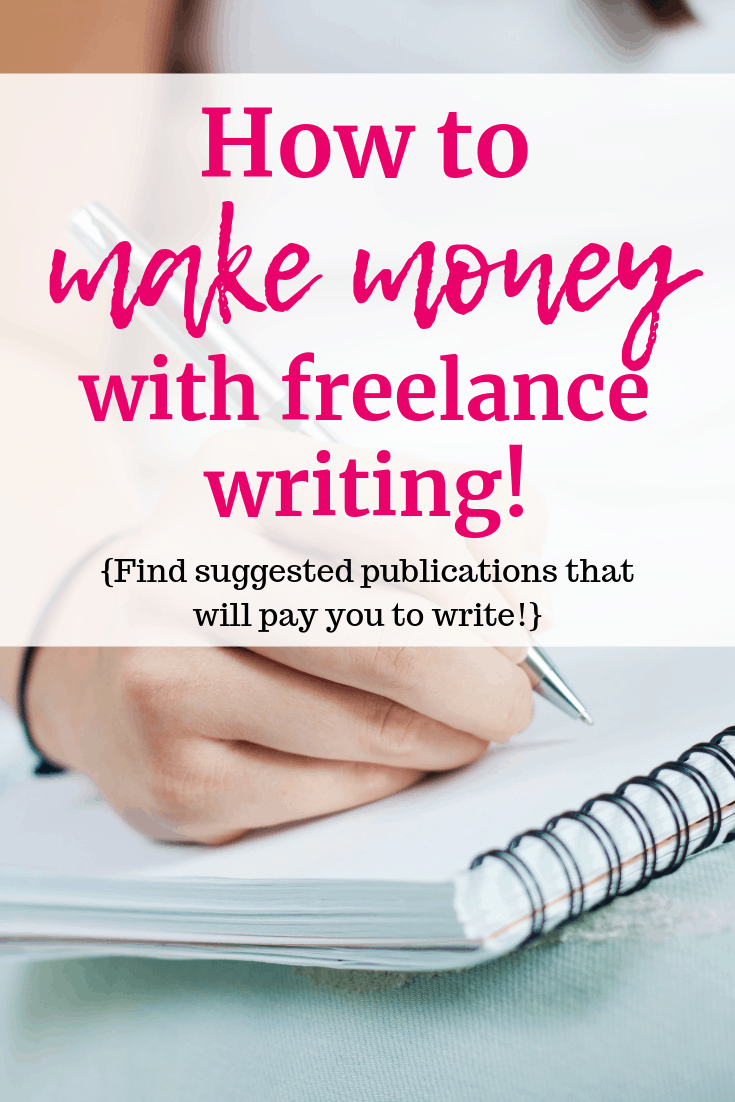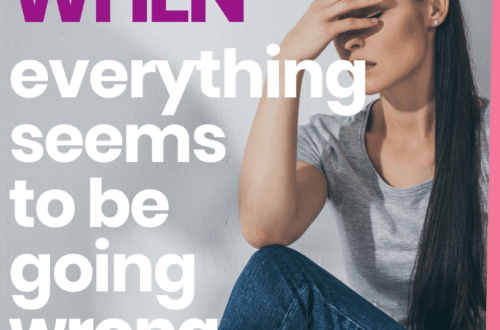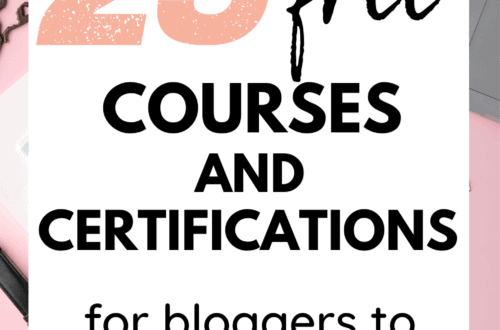
Freelance Writing Jobs for Beginners: Must-Know Tips + Where to Pitch!
Whether you’re growing your blog and need to supplement your income for a bit, or if you just love writing and want extra opportunities – freelance writing is a great option. It can seem a little overwhelming at first to get started, but this post will break down everything you need to know about freelance writing jobs for beginners.
Benefits of freelance writing for bloggers
Clearly, the biggest benefit to freelancing is the extra moolah! 😉 You might be looking into it as a side hustle or to keep some extra income flowing as you grow your own site.
But there are other benefits to freelancing as well:
- Establish expertise in a particular area/field
- Improve writing style and experience
- Get author mentions on reputable sites, which may help your own site’s SEO
- Less commonly but still possible – getting some backlinks to your own blog content which can help with SEO
Getting Started
I think there are two common factors that tend to stop people in their tracks when it comes to freelance writing:
- Fear
- Lack of knowledge on where to find jobs
The later is easy to fix, and I’m going to help you with that in the rest of this post.
But it’s the former that tends to be the biggest stumbling block. You might be feeling “imposter syndrome”, thinking to yourself “I’m not a real writer.” Or you might be afraid of getting rejected. Or maybe you want to share big things with the world, but you’re afraid of how people will react to those articles you write.
You gotta let all that go, friends. Many of ya’ll are credentialed wellness professionals or have a degree in your field, and you absolutely have the expertise to write. Don’t hide those credentials, let them shine!
Even if you aren’t credentialed and just love your field, there are a billion topics out there in wellness and other fields that you can lend your unique voice to. You don’t have to be a dietitian to write about “15 hacks to make meal prep go faster”, nor do you have to be a personal trainer to share “10 fitspo quotes that will make you want to hit up the gym right now.”
Of course, I’m not saying go out there and write about scleroderma or cross fit workouts if you know nothing about those topics. You want to be sincere and recognize both your own areas of expertise and your own limitations as far as what you should be talking about (For example, I’m not a doctor, so no way in heck am I going to write an article about how to treat a broken nose. Not only is it crazy for me to even try to do that, but it opens me up to a lot of liability).
BUT – just let the fear go that you’re not a “good enough” writer or a well-known enough professional to get into big name publications. Put in the hard work and you can do it.
PS – While I’ve got some basic info below about where to look for jobs and some sample publications, a pal of mine, Ana, has put together an in-depth course about freelance writing (affiliate link – I earn a commission on purchases) specifically for RDs and credentialed wellness professionals. If that’s you, definitely check out her course which will have you confident and pitching in no time!
Where to look for freelance writing jobs for beginners
Finding freelance opportunities can be hard at first, but there are lots of places to look. Remember to be proactive! While some jobs may just land in your inbox or get passed along to you, at the beginning you’ll likely need to pitch your ideas frequently or stay active on social to scope out possible opportunities.
Here are three places you should check out:
Job boards
Job boards are likely where many beginner freelance writers start. They’re a great option as you get started. If you want to check these out, I would look into the following sites:
Social media
Another option is to go head first into social media. This is a great way to connect with others, be seen as an expert, and find jobs. There are a number of ways to go about this such as:
- Interact in professional Facebook groups for your niche (for example, my main freelance gig was the result of me responding to a Facebook post in an RD blogging group)
- Check Facebook groups for writers and marketers, where opportunities may be posted (for example, I love the Social Media, Marketing & PR Jobs Facebook group – it’s more targeted towards social jobs but there are often content creator jobs!)
- DM Wellness Sites/Brands on Instagram to connect, and see if they need writers
- Follow your favorite brands and publications on Facebook to see if they post opportunities for freelancers
- Join VA Facebook groups where you can advertise article topics that you will write for other bloggers (for example, VA for Hire and Pinterest Friendly Content for Bloggers has a big audience of bloggers looking to purchase freelance articles)
Publications
While both options above are great, they can take some time to find the right fit. Social media isn’t an overnight strategy and job boards can be either low paying or very competitive.
The most proactive option – which often has the best results – is to find publications that are already paying well and go after them. These can be major magazines, niche websites, or regional publications.
Also, don’t discount professional publications. One of my earliest print assignments was a continuing education article in Today’s Dietitian magazine. And this year, I’ve been writing for ANFP’s “The Edge” magazine, an industry publication for Certified Dietary Managers. It’s one of my favorite assignments!
Suggested Publications that Pay Freelancers
There are endless opportunities out there. I’ve nailed down some below, but I’m sure you’ll realize this is no where near a comprehensive list.
I’m focusing on some of the ones relevant to the wellness industry but if you happen to be a mom blogger or travel blogger reading this post – there’s definitely publications out there for you too!
1. Eating Well
Eating Well is a publication that focuses in on healthy eating. If that is your jam, this would be perfect for you!
They are looking for articles such as cooking and nutrition science, origins of food, and social issues related to food. They target both men and women and take a news and science approach to publications.
They ask that you pitch them simple ideas first to win the chance for longer articles.
When pitching them, describe your idea in 2-3 and how it fits into their magazine. They also ask you to share some information about you, your experience, what you like to write, and any other publications you have written for.
Allow 3-4 weeks for a response and then send a follow-up email. If approved, you’ll write your full article and it will be published in 3-6 months.
Requirements vary depending on the column you wish to write for and they have a few editors taking pitches. Refer to the website for more information.
Pay is currently up to $1/word.
2. Backpacker
If a hike in the back country is your idea of a perfect day, this might be a great freelance opportunity for you. Backpacker covers topics like hiking tips, destinations, personality profiles of backcountry hikers, or gear reviews.
Pitch them a query first – do not email them with full article attachments.
Be sure to thoroughly review all their guidelines, and make sure you’re familiar with the style and voice of the publication.
Lead time is 6 months for print and 1 month for online work. Allow 2 to 4 weeks for replies on print stories, or up to 2 weeks for queries on web-only pieces. Be sure to pitch the correct editors, who are in the guidelines linked above.
Word count varies based on the type of article.
Pay is currently up to $0.40 to $1/word.
3. IDEA
IDEA is a health and fitness association with articles in the wellness industry. Their readers include personal trainers, health coaches, fitness instructors, program directors, nutrition professionals, and other health and wellness professionals.
They are looking for topics in the fitness, nutrition, recovery, and behavior areas. Articles should be interesting, meaningful, and timely. They also should balance research with practical information in order to empower and inspire their readers.
Articles are required to be at least 1,400-1,800 words long, while features should be 3,000-3,500 words. All content should be original, directly address the needs of their readers, be evidence-based, and reflect your own qualifications as an expert.
You are required to submit a query letter that includes the following:
- The topic and questions you will answer
- Why the idea is relevant to fitness and health professionals
- Why you are the person to write the article
- General topics or points you will cover via a list or outline
- How you will include practical how-to information
- A short list or links to peer-reviewed research you will use to support your article
The approval process takes 6-8 weeks and payout is 60 days after acceptance. Rates vary as they are not publicly listed.
4. Men’s Fitness
Next up is Men’s Fitness Magazine! This is an Australian magazine that (obviously) targets men who are interested in fitness.
They cover topics such as:
- Exercise
- Health
- Nutrition
- Training
- Sports
- Entertainment
They ask that you read the magazine prior to submission. When pitching, send an overview no longer than 200 words that includes who you’re talking to, what section it is for, and what it is about. Be sure to also include your writing experience.
They specify it can take a month to get a reply. Rates are not listed publicly, and I’m unsure if they accept US writers or only those in Australia, but it’s certainly worth a shot.
5. Food and Nutrition Magazine
Any of my fellow RD pals are probably familiar with this publication! It’s published by the Academy of Nutrition and Dietetics and sent bi-monthly to members, associates, and subscribers. They cover nutrition topics, recipes, and product reviews.
To pitch an idea, you’ll want to thoroughly read the guidelines on their site and use their online form for submission. Do not email editors directly (unlike most other publications) in an attempt to skip this online submission system.
When you do submit a pitch, be sure to describe why it’s timely and relevant, and any references you plan to use.
Article assignments range in length from 350 words on the low end to up to 3500 words on the high end.
Payment rates are not posted but are described as being “competitive.”
6. Mother Earth Living
Mother Earth Living is a publication that writes in the areas of healthy home, food and recipes, health and wellness, and gardening. Their audience includes consumers who strive to create a healthy home and lifestyle for their families, while staying environmentally conscious.
Articles should be informative, well written, and detailed. A reader should understand basics, how to get started, and where to turn for more information. Be sure to address beginners!
Pitch them your idea with a query letter than is 2-3 sentences. Include the topic, main points, the approximate length, and formatting ideas. Acceptance may take 3-6 months with their editorial advisory group.
Payment is paid upon publication at varying rates.
7. Well Being
Well Being is another Australian publication. The print magazine is about improving the quality of life for yourself and others as well as the planet. They suggest reading a publication prior to submission.
Topics include the following:
- Natural health
- Spirituality
- Natural therapies
- Esoteric
- Fitness
- Environment
- Animals
- Wholefood cooking
- Natural beauty
- Travel
- Children
All articles should be informative, empowering, and entertaining. They do have a number of submission guidelines, such as writing style, tone, and word count. Features must be 2,000-2,500 words while “real life experience” articles are 800-1,000 words. They also ask to always check your sources so that they are first-hand and credible.
Be sure to check their site for a full overview of requirements.
The acceptance process will take up to 3-4 months and not all submissions are accepted. Payments and contracts are sent upon publication.
Payment varies in the range of approximately $100-$1100 (USD), depending on the type of article.
8. Whole Life Times
Whole Life Times is a publication in the holistic health community. They source their entire publication with freelancers so this is a great option to consider.
They are seeking stories around topics such as:
- Holistic and integrative health
- Alternative healing
- Green living
- Sustainability and organic food
- Yoga
- Spirituality and personal growth
- Social responsibility
- Conscious business
- Environment
The acceptance process takes approximately 2 months. Email the editor with a query letter including past published clips, bio, and topic. You can also submit a manuscript including approach to your topic, timeliness of the issue, and the quality of your writing.
They prefer thoughtful and researched articles with an informed tone. They like a narrative approach with emphasised storytelling.
They currently pay anywhere from $35-150 per piece. Rates depend on topic, word count, and writer experience. That’s not a fantastic rate, but it’s also somewhere to start if you’re just looking to break into freelancing and need to get a publication under your belt.
9. Diabetes Self Management
If you have some experience with Diabetes, this is a great publication to submit work to! They have topics that include management as well as recipes, nutrition, and exercise. Their readers are seeking up to date and authoritative information.
Topics include the following:
- Nutrition
- Pharmacology
- Exercise
- Medical advances
- Self-Help
Articles must be 1,500-2,500 words and be original work. They focus on day-to-day problems and publications must be clear, concise, interesting, and instructive. They do not assume knowledge of their audience as it ranges from newly diagnosed to patients who have been familiar with their diagnosis for a while.
They also ask to use plain English and avoid medical jargon unless explaining technical terms in a simple and easy to understand manner. Reliable sources can be used and are encouraged to be used within the article for readers to expand their learning.
To submit an article, email the editor with a query letter. Include a 1-page outline and writing samples.
Payment rates vary at this time.
10. Triathlete Magazine
I can’t believe I haven’t submitted anything to Triathlete Magazine yet, because this is totally in my wheelhouse!
Topics include the following:
- Triathlon training tips
- Nutrition for triathletes
- Gear
- Apparel
- Athlete profiles
- Travel stories related to triathlon
- Multisport news
To submit your idea, email over a query with an outline of your topic. They do specifically request that you include references/credentials if you’re submitting an article on nutrition or training.
Articles length varies and the magazine will own copyright. Generally full feature articles will run around 800-1200 words, while training tips or nutrition articles are shorter at around 200-500 words.
Payment rates are not posted but it is a compensated opportunity.
11. Chatelaine
The last one I have for you today is the Chatelaine; a Canadian Women’s magazine. They do cover a variety of topics but do have a health column.
To pitch your idea, email them a 1-page query letter outlining your idea. They have a high volume of pitches so be sure to tell them directly how it fits into the magazine, what section it will go into, whether you envision it for print or digital, and the format. They ask to send unique pitches tailored to them. (In other words, do not send the same idea to another publication.) They also ask to link or attach 2+ pieces that have already been published.
At this time, lead time for print articles is 4-6 months in advance of publication. Allow 6-8 weeks before following up. Upon acceptance, you will also receive a contract, deadline, and fee they are offering.
The fee varies at this time and will be presented upon acceptance.
Final thoughts on freelance writing jobs for beginners
I know that can seem a little overwhelming, but you got this! Breaking into freelance writing jobs for beginners can be so rewarding.
The list above is just a SMALL sample of all the publications that will pay for your work – not to mention brands that are looking for freelance writers for their content too! If you’re looking for more publications or those outside of the wellness industry, definitely check out the Writers Market at All Freelance Writing which has hundreds of publications listed that hire freelancers!
Here are a few additional tips as you get started:
- The number one thing to keep in the forefront as you seek out jobs is to make it a priority to serve your potential clients. When submitting article ideas, personalize it and make a lasting impression.
- Try to keep everything in the body of the email and avoid attachments unless specifically requested. Attachments can cause an email to bounce back or get filtered into spam.
- Give it a little bit of time for follow up. Even though you’re excited and a few days feels like forever, a lot of these editors are working under pressure and have tons of competing responsibilities. Try following up in a few weeks.
- Don’t copy and paste the same pitch to 5 different places and email them all the same day. If multiple are interested, you’ve put yourself in a pickle.
- I mentioned lead time quite a bit in here; if you’re not familiar with that term – it means how far in advance you need to be pitching the article prior to it potentially being published. For example, you may be pitching an article in snowy January – but if the lead time is 6 months, that means it may not go to print until June. Keep this in mind for anything seasonal.
- Get creative with your article ideas. Think of new takes on an always-popular topic, or about current trends in the field. (Matcha and keto, anyone?)
- Don’t forget about pitching publications in the digital space in addition to print. Digital rates tend to be a bit less than print, but they also are often more casual and require less lead time. (Plus, if you are totally rocking your SEO optimization or know how to craft a great viral post title, those skills will definitely get you some repeat business).
- Again, if you need more guidance or a step-by-step system to work through, definitely check out my friend Ana’s course on freelance writing (affiliate link – I earn a commission on purchases) that’s specifically for wellness professionals.
- Be patient, strive for quality, and go start applying!
GOOD LUCK! 🙂
Share: Any other tips to share for those looking for freelance writing jobs for beginners? If you’re just getting started, any questions that you might have?






